David Black (Czech David Černý; born December 15, 1967, Prague) is one of the most famous modern Czech sculptors, the author of scandalous works combining humor, provocation, social and political satire. The works of David Cherny often aroused sharp criticism of the public, however, a number of his works installed in Prague were widely recognized and became one of the brightest sights of the Czech capital. I bring a small part of his work, if you are interested, you will easily find information on him and his work, and many photographs of creations)) The first, which became famous, the sculptor's work is a pink tank. The Soviet tank IS-2, mounted on Kinsky Square in Prague Smichov in memory of the liberation of Prague by the Red Army in 1945, was painted pink on the night of April 27-28, 1991 and a finger was installed on the roof of the tank tower in the form of a well-known gesture. According to David Cherny, his goal was to ridicule the symbolism of Soviet military monuments, interpreted as a threat to the civilian population by force. The Czech tank in the Czech consciousness was associated with tanks on the streets of Prague during the suppression of the Prague spring of 1968 and the subsequent “period of Soviet occupation” and was no longer perceived as a symbol of liberation from fascism. The finger was then removed from the tank, but the color was left. “The Horse” is another famous work of David. It dates from 1999 and symbolizes mockery on the pathos of Wenceslas Square and the monument to St. Wenceslas standing there. As you can see, at David the Black Wenceslas sits on the belly of a dead horse.  But such "kids" are crawling along the Zizkov TV tower. In truth, it looks pretty creepy near)))
But such "kids" are crawling along the Zizkov TV tower. In truth, it looks pretty creepy near))) 
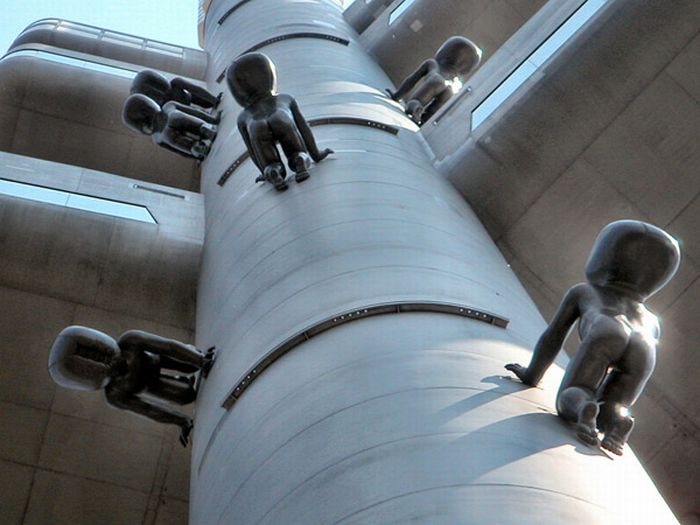 "People" car "Trabant" got on its feet))
"People" car "Trabant" got on its feet)) 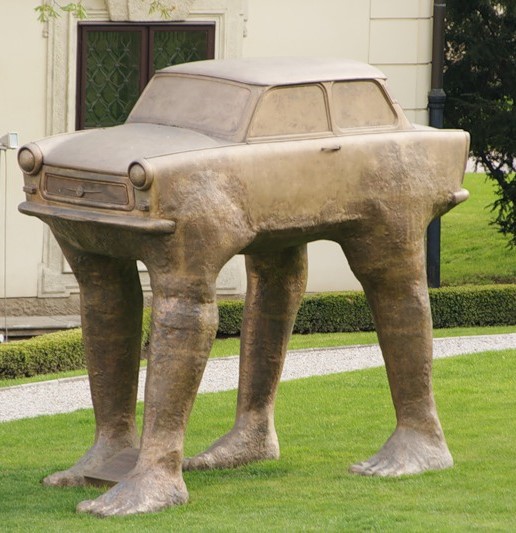 When descending to Mala Strana from Grad, the former brick factory Gergeta is on the left hand. Now here is one of the Prague museums dedicated to Franz Kafka, in the courtyard of which Cherny put up two bronze male figures. They stand in the middle of a shallow basin with the outlines of the Czech Republic. Using the mechanism, some ... umm ... parts of the sculpture can move up and down. In addition, a fully conscious direction can be given to the jet. So the statues are able to display meaningful texts on the water, including those at the request of those who wish. (imagine. what an original declaration of love can be made ...)))
When descending to Mala Strana from Grad, the former brick factory Gergeta is on the left hand. Now here is one of the Prague museums dedicated to Franz Kafka, in the courtyard of which Cherny put up two bronze male figures. They stand in the middle of a shallow basin with the outlines of the Czech Republic. Using the mechanism, some ... umm ... parts of the sculpture can move up and down. In addition, a fully conscious direction can be given to the jet. So the statues are able to display meaningful texts on the water, including those at the request of those who wish. (imagine. what an original declaration of love can be made ...)))  And this poor Freud is hanging over the street, not on a rope, as it might seem, but holding on to the beam with his hand. One of the main versions of the sculptor’s intention in this work is the desire to show the isolation of the intelligentsia from the people.
And this poor Freud is hanging over the street, not on a rope, as it might seem, but holding on to the beam with his hand. One of the main versions of the sculptor’s intention in this work is the desire to show the isolation of the intelligentsia from the people. 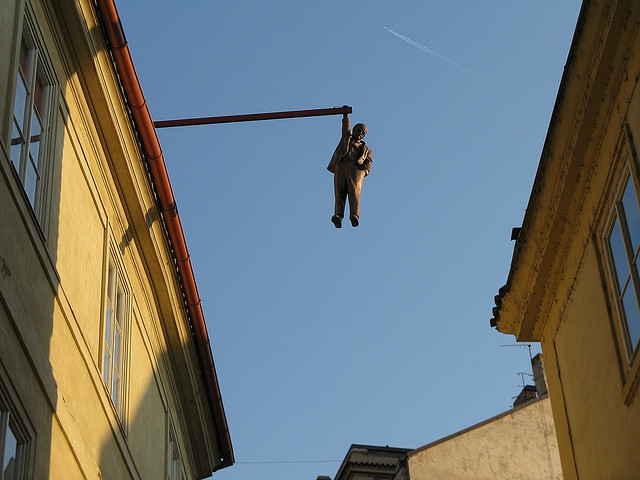 metamorphoses installation (2007) in Charlotte, North Carolina (a stainless steel human head with a mouth-blowing fountain, constantly transforming and managed by the artist over the Internet)
metamorphoses installation (2007) in Charlotte, North Carolina (a stainless steel human head with a mouth-blowing fountain, constantly transforming and managed by the artist over the Internet) 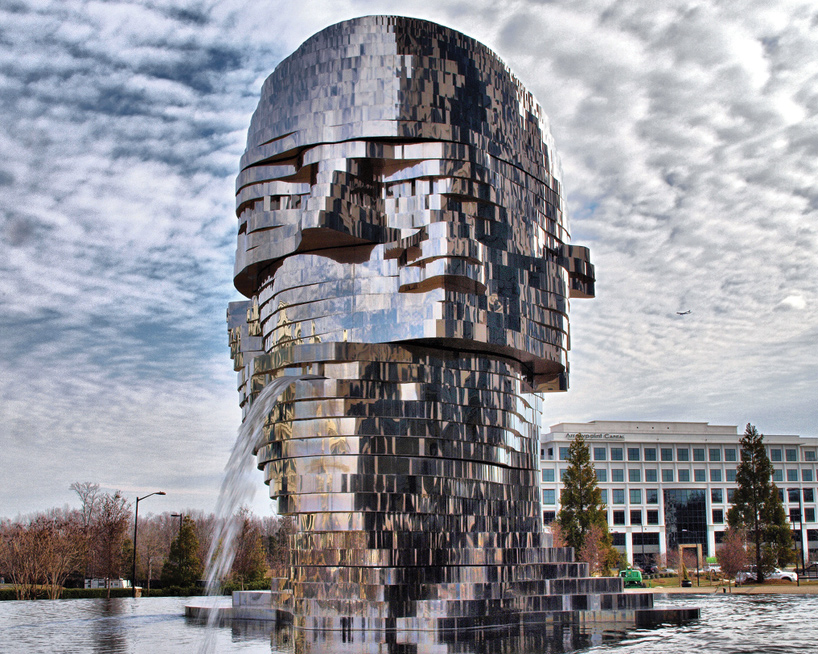 And, of course, one cannot fail to mention Entrop. The composition is timed to the beginning of the Czech presidency of the European Community. It was assumed that it was created by 27 artists and groups of artists from various countries of the European Union, however, it later became clear that only Black and his three assistants took part in its creation. The image of each country reflects a stereotypical view of it. Many countries did not appreciate the humor and were seriously offended.
And, of course, one cannot fail to mention Entrop. The composition is timed to the beginning of the Czech presidency of the European Community. It was assumed that it was created by 27 artists and groups of artists from various countries of the European Union, however, it later became clear that only Black and his three assistants took part in its creation. The image of each country reflects a stereotypical view of it. Many countries did not appreciate the humor and were seriously offended.  Here, for example, Bulgaria in the form of, sorry, toilet.
Here, for example, Bulgaria in the form of, sorry, toilet. 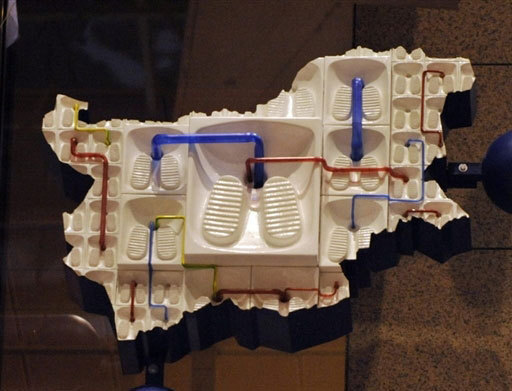 And this is Germany, the autobahn. Do your contours remind you of anything?
And this is Germany, the autobahn. Do your contours remind you of anything?  Luxembourg is a piece of gold for sale.
Luxembourg is a piece of gold for sale. 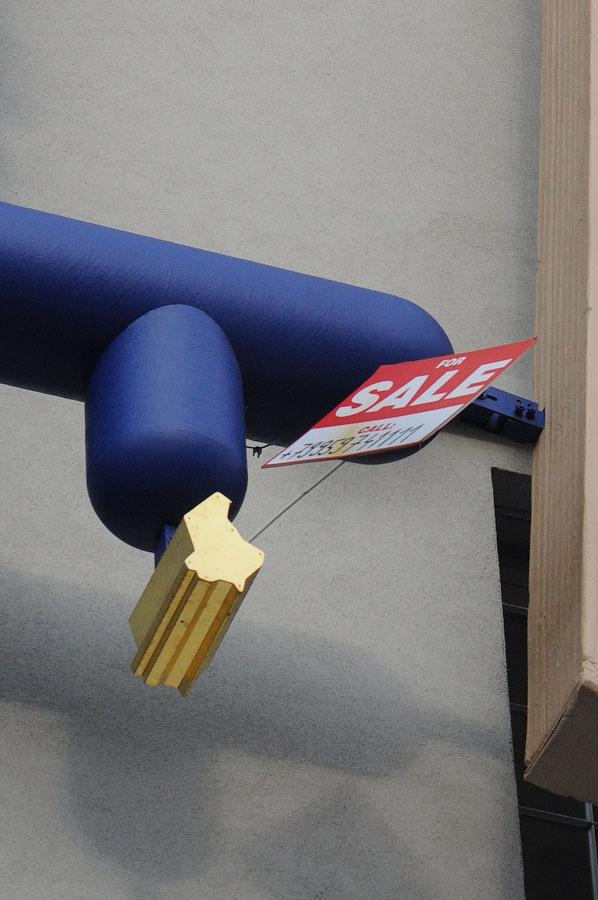 Romania is represented as the castle of Count Dracula.
Romania is represented as the castle of Count Dracula. 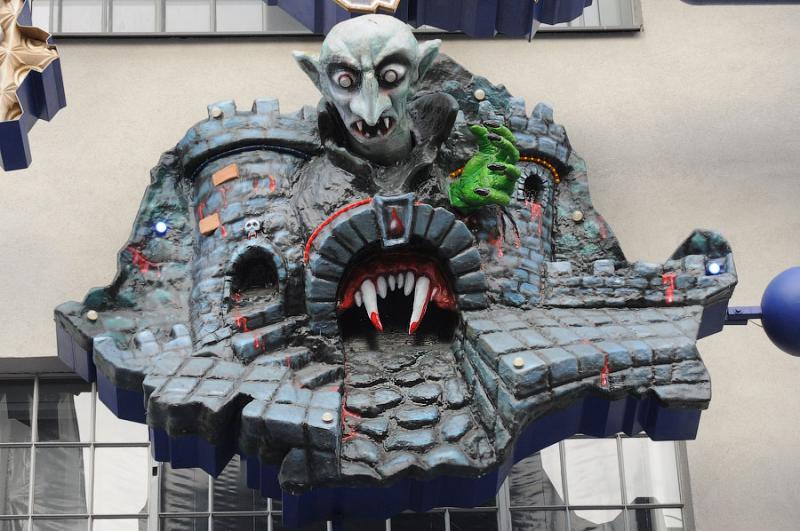 but Belgium was lucky: a box of chocolates is far from the worst option))
but Belgium was lucky: a box of chocolates is far from the worst option)) 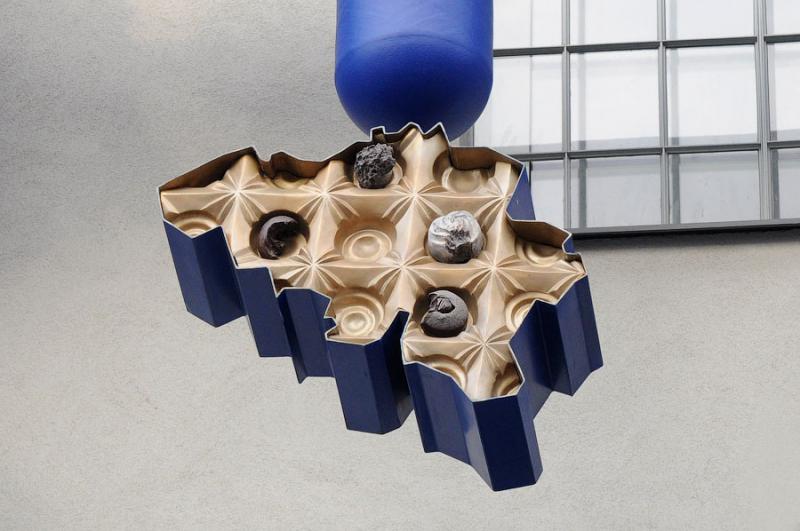
Monument to Soviet Tankers (Czech Památník sovětských tankistů; also known as " Tank number 23"(Czech. Tank číslo 23) and" Smikhovsky tank"(Czech. Smíchovský tank)) - a monument erected on July 29, 1945 in Prague (Czechoslovakia) in honor of Soviet soldiers who came to the aid of rebellious Prague on May 9, 1945 at the end of World War II.
However, instead of the “thirty-four” guards of lieutenant I. G. Goncharenko, a heavy tank IS-2, built in 1943 at the Kirov plant in Chelyabinsk, was loaded on a quadrangle pedestal made by captured Germans. According to legend, the decision to replace the T-34 with the IS-2 was made by General D. D. Lelyushenko, critical of the damaged T-34-85 tank I. G. Goncharenko, who said: “We won’t give such junk to the Czechs.” In addition, IS-2 was marked with number 23 (instead of real number 24) and a red star, which was not on the tank of I. G. Goncharenko. Until the end of the 1980s, the official version claimed that the very “first” tank was actually exhibited in Prague. On the pedestal were installed brass tablets with the inscription: “Eternal glory to the heroes of the guard tankmen of General Lelyushenko, who fell in the struggle for freedom and independence of our great Soviet Motherland. May 9, 1945 ”, and the square with the monument was renamed the Soviet Tankers Square.
"Pink Tank"
After the “velvet revolution”, the inhabitants of Prague learned that all these decades on the pedestal was not a lined T-34-85 guard of Lieutenant I. G. Goncharenko, but another tank (IS-2). Against the background of the talk that there was no moral reason to leave the Soviet tank on a pedestal, on the night of April 28, 1991, the future sculptor, and at that moment a 23-year-old student
David Cerny - One of the most famous modern Czech sculptors, the author of scandalous works combining humor, provocation, social and political satire. The works of David Cherny often aroused sharp criticism of the public, however, a number of his works installed in Prague were widely recognized and became one of the brightest sights of the Czech capital. Prague would not have been Prague, had not the young sculptor worked on its appearance;)
David Cerny was born on December 15, 1967 in Prague. His family was closely associated with art: his father was a graphic artist, and his mother was a restorer. Even in his childhood, David was distinguished by a rebellious spirit: a drawing teacher once isolated him from the rest of the class because of hooligan behavior, the press also published information that two school teachers were sent to a psychiatric clinic because of Cerny.
Cerny at first refused to follow in the footsteps of his parents and was engaged in electrical engineering, soldering electrical circuits. However, this soon bored him, and he decided to enter the Prague Higher School of Industrial Art, but for three consecutive years he could not pass the entrance exams. However, in 1988 he succeeded. Cerny graduated from school in 1996, although during the entire period of study he studied in it for no more than three months due to the lack of equipped workshops.
Cerny's fame was brought about by his performance in 1991, which caused a wide public outcry: on the night of April 27-28, he and his friends painted pink the IS-2 Soviet tank, which was located on the square in front of the Palace of Justice. It was believed that this is the first tank that entered the city in 1945, and it symbolizes the liberation of Prague by Soviet troops from the Nazis. However, after the events of 1968 - when the Warsaw Pact countries invaded Czechoslovakia - the monument began to be perceived as a symbol of communism and Soviet occupation.
The bully was found. Yes, he was not hiding, claiming that the pink tank is not vandalism, but an art action directed against the symbols embedded in the Soviet military monument. Cerna’s arguments were not accepted, and he was arrested, the green livery was returned to the tank, however, 10 days later, using parliamentary immunity, 15 members of the Czech parliament re-painted the tank pink. Cerny was released, and the monument was dismantled.
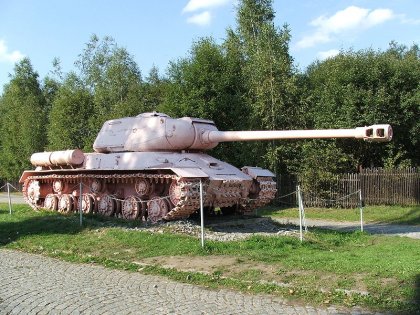
Among the works of David Cherny stand out:
Sculpture Quo vadis (Where you go) (1990)
This is one of the first works that brought the author popularity. The sculpture, installed at the German embassy in Prague, is a "folk" car "trabant" on human legs. Dedicated to political refugees from East Germany. In 1989, before the fall of the Berlin Wall, Germans from the German Democratic Republic, who did not need a Czech visa, drove to Prague in crowds on their "trabans", threw cars at the German embassy and fled to seek political asylum.
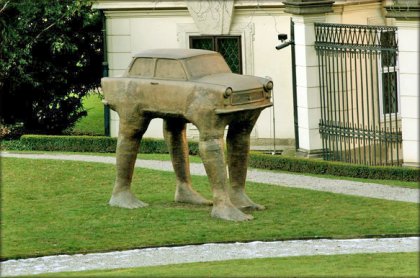
The Hanging Man (1996)
The sculpture is a figure of Sigmund Freud (some Czechs believe that this is Lenin) in full height, which hangs over the street, clinging with one hand to the horizontal mast. At dusk, she is often confused with a real person.



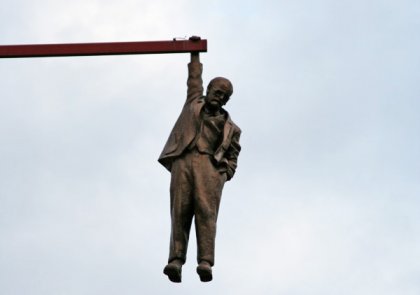
Installation "Embryo" (1996)
On the occasion of the 50th anniversary of the Na Zábradlí Prague Theater, David Cerny made such a gift. On the wall of the building in which the theater is located, an embryo appeared on the umbilical cord. At the same time, the umbilical cord serves as an ordinary drainpipe on the side of the building. As conceived by the author, Embryo symbolizes the origin of creativity. Despite the fact that this sculpture is absolutely not contradictory and harmoniously fits into the appearance of the building, Cerny nevertheless underwent a wave of criticism. Even the theater staff themselves were divided into two camps: those who are happy with the gift, and those who want to refuse it. Most of all, tourists are pleased with the sculpture, since after sunset it begins to flicker with a pleasant reddish light.
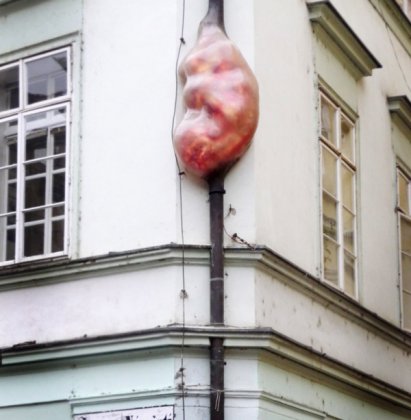
The sculpture "Horse" (1999)
This is Cerny's most famous work. It depicts St. Wenceslas, sitting astride the belly of a dead horse and suspended by the legs. It was installed in 1999 on Wenceslas Square in Prague opposite the usual equestrian monument to the king. At present, the sculpture is in the passage of "Lucerne" on Vodichkova street. Represents metaphorical criticism of the Czech government.

Giant Babies (2000)
In 2000, a sculpture in the form of giant (3.5 meters long) faceless babies crawling at high altitude up and down the walls of the tower was placed on the Prague TV tower in Zizkov. Thanks to these alien babies, the television tower has become one of the most popular tourist sites in Prague.
Giant babies were invented by the sculptor in 1994, when he lived in New York, for the Museum of Modern Art in Chicago. However, the museum did not find money for the installation, and the figures wandered around the exhibitions for a while, having managed to even visit Kiev.
In 2000, when Prague was declared one of the cultural capitals of Europe, David Cerny lived in the Zizkov district of Prague. Local authorities asked him to do something for the area. So ten "negroes" appeared on the Zizkov television tower. True, negotiations with the authorities took as much as a year and a half. The sculptor carefully chose a place on the tower for each of the babies, and is still unhappy with the location of one of them.
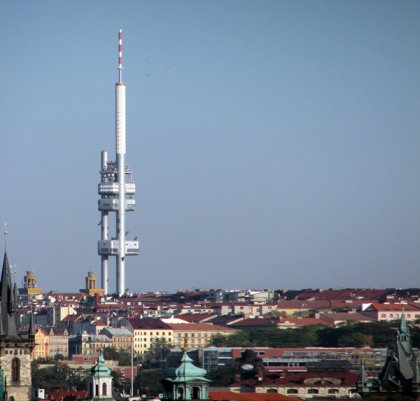
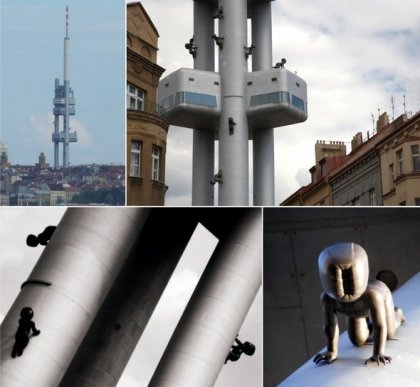
![]()
Among the unrealized projects is an installation for the National Theater called "The people themselves forever" (2002). The theater was built with money raised by the people. Immediately after the opening, in 1881, a terrible fire occurred in the building, and the Czechs again raised money for the restoration of the theater - a million zloty in just 47 days. Therefore, the motto of the theater is the same - "People for themselves."
David Cerny wanted to place a ten-meter golden sculpture of a naked Titan on the roof of the theater, from the penis of which from time to time streams of water would quite burst out in a very unambiguous way. On the one hand, the figure would hint at the history and motto of the theater, partly symbolizing the fire hose, on the other hand, this would be a little hooliganism with respect to passers-by below.
The sculpture was supposed to be installed in May 2003, on the eve of the referendum on the entry of the Czech Republic into the European Union. The project was generously sponsored by a person who wished to remain anonymous, but the theater leadership finally decided to abandon it, as Cherney writes, "afraid to lose their places."
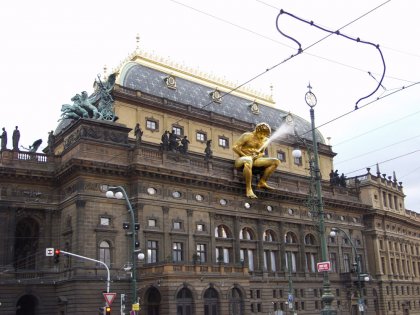
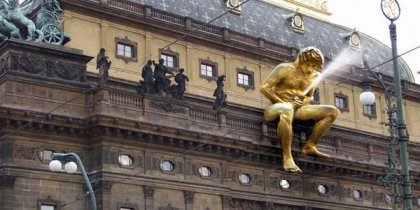
And this installation of Cerna (2003) is in one of the Prague galleries of Contemporary Art. Here you can really look into the ass. contemporary art.

Being a “technical” man, David Cerny gives many of his works not quite sculptural possibilities. So, his 2004 project Piss - Gergeta Brick Factory, represents two bronze figures, pissing in a reservoir, reminiscent of its outline map of the Czech Republic. they’re not just pouring water, but jets out various texts, including those on request. So, you can even make the statues “write” their own phrase by sending an SMS message from a mobile phone.

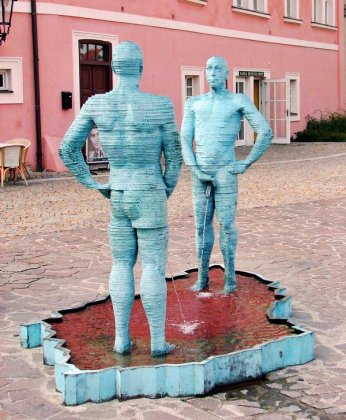
Banquet of the Giants (2005)
Bus stop in the city of Liberts, stylized as a giant bronze table, set for dinner. On the table, among the beer mugs, is a head with glasses, into which a knife and fork are stuck. This is the head of Konrad Henlein, who was a Reich governor in these places during the years of fascist occupation.

![]()

In 2005, Cerna’s other scandalous work gained fame: it was a parody of Damien Hirst’s work “Physical Impossibility of Death in the Living Consciousness”, in which a shark was placed in a formaldehyde aquarium. Instead of a shark, Cerny placed in a yellow-green solution of formaldehyde a figure of a half-naked man, Saddam Hussein, who was hanged. Subsequently, the Iraqi ambassador to the Czech Republic demanded that this sculpture be removed from the exhibition, and it was banned for display in Belgium and Poland.
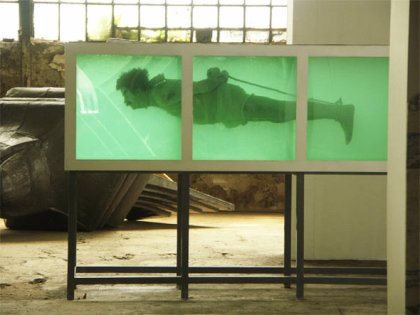
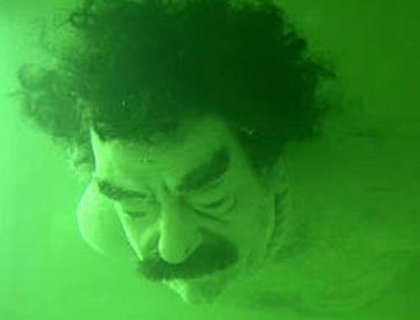
Fountain "Metamorphoses" (2007)
It is located in North Carolina and is a metal head that can change its shape, and Cherney himself can control it through the Internet.
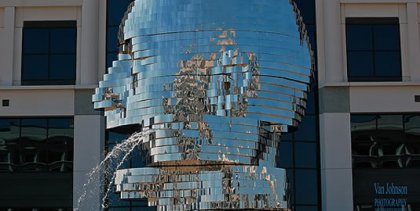

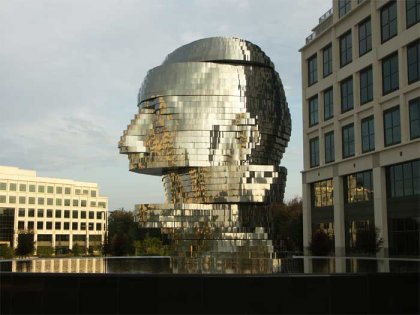
Of course, this is not all the work of an art bully. His works were exhibited at many museums and galleries, for his bold views he gained not only fans, but also enemies.
David Cerny believes that art should contain some message, carry some kind of subtext. And provocation is just a more compelling message. The joker is often asked what he wants to say with this or that job. However, the sculptor believes that the main thing is to explain it to yourself, and some things do not need to be explained to people at all - let them guess for themselves. And in fact, over the creations of David Cerna you can sometimes puzzle for a long time.
The exhibition Кmeny-90 ’is organized by the Moravian Art Gallery and should last two months. According to activists detained by police on Saturday, "the non-artist Cherny desecrated the tank, which is a symbol of liberation from German fascism and 150 thousand Red Army soldiers who died for our freedom." After the invasion of Soviet tanks in Czechoslovakia in 1968, many, however, perceived the monument tank, which stood on the Prague Smichov and was intended to recall the Red Army soldiers who died during the liberation of Czechoslovakia from the Nazis, already as a symbol of Soviet occupation. In January 1991, the historian Pavel Bjelina voiced the opinion that "there are no historical or moral reasons to leave the tank on Smichov." And in April 1991, David Cerny, who was still a student at that time, repainted it in pink, and also placed a creative decoration element on it - the middle finger raised up, peeking out of the tank’s tower. The action had both supporters and opponents. Three days later, the city administration repainted the tank back to green, but 15 deputies of the Federal Assembly from the Civil Forum, using their deputy immunity, turned it into pink again in May. The object of contention was eventually deprived of the status of a national monument and on June 13, 1991, during the reconstruction of the square, it was completely removed. Since 1995, this combat vehicle on track number 23 has become an exhibit of the Leshan Military Technical Museum, 30 km from Prague.
Some of the witnesses of the color reincarnations joke in connection with the Brno episode - well, it’s not a tank, but a real chameleon - then green, then pink. However, did he again become a barometer measuring the degree of public opinion?
"Russia tactlessly increases its power in the Czech Republic"
The curator of the exhibition project is an artist acting under the pseudonym Vladimir 518.
“We were looking for a suitable symbol of the 1990s, and the choice fell on“ Pink tank". This installation gave rise to a new wave and symbolizes the emergence of the transformation process that our society has gone through. ”
Has something changed 26 years after the repainting of the tank in the perception of the significance of this sensational art object by the artist himself?
“In my eyes, this is a past historical stage and a very brief chapter of my life. At that time, the Russians who were here were not particularly favored, but at present Russia in our country is rather tactlessly building up its power. This is terrible, ”said David Cerny, who was famous for such provocative artifacts as the Entropa panel, which led to diplomatic scandal in the first weeks of the Czech Republic’s presidency of the European Union, and the Shark, which was banned in some countries. It is difficult to find a tourist who, having been in Prague, would not have seen in the passage "Lucerne" St. Wenceslas, sitting on an inverted dead horse, or ebonite-black babies, mastering the crawl on the Prague TV tower. The sculptor emphasized that "the tank served as a symbol of the occupying forces and nothing more."
The tank, currently standing on Comenius Square, again in the pink version, is fenced with ropes on all sides to avoid repeating the Saturday script. Two days before the Brno repainting episode, activists covered the exhibit with a blue film with the inscription Slušní lidé (“Honest People”). They believe that this installation is an insult to the memory of all the soldiers who fought against fascism. Law enforcement officers remotely watched what was happening, but upon arriving at the square, none of the participants in the initiative who were facing an administrative fine of 30 thousand kroons (1,100 euros) was not found there.
BATTLE AT MANESOVA BRIDGE
When Kamatai Tokabaev was called up for war in 1942, he was only 18 years old. The division of recruits was immediately thrown into the Stalingrad furnace, where they had already finished off the German army of Paulus, who surrounded this legendary city on the Volga. May 1945, Sergeant Kamatai Tokabaev met already in Berlin, from where he and his fellow soldiers were urgently transferred to Prague.
It is known that the German command at the end of the war intended to turn Prague into a second Berlin. However, this plan was disrupted on May 5, 1945 by the uprising of Czech patriots. In the former Soviet republics, little is said that the plans of the last Hitler generals were also hindered by the Vlasov army, which at the last moment turned their bayonets against their German masters. But the main burden of the last battles fell on the shoulders of the Soviet army.
Sergeant Kamatai Tokabaev’s Guard was ordered to ensure the safety of one of the bridges across the Vltava River. Here, on the last day of the war in Europe, on May 5, 1945, Lieutenant Ivan Goncharenko died - very soon his name was turned into a symbol of the liberation of Czechoslovakia from fascism. For Kamatai Tokabaev, the name of his famous fellow soldier became a matter of personal pride, and all these 65 years he dreamed of somehow getting to Prague and seeing Goncharenko’s tank on a pedestal at the place of his death.
The tank under the command of Lieutenant Ivan Goncharenko was the first to slip through Manesov bridge, but ran into cannon fire
German self-propelled guns. In the summer of 1945, it was announced that the tank of Lieutenant Ivan Goncharenko was erected on a pedestal in the center of Prague. At the opening of the monument, even the famous Soviet marshal Ivan Konev participated. Official legends were widely duplicated in Czechoslovak cinema, in books, in memoirs of Soviet front-line soldiers. For example, in 1950, a Czech writer published a story for children, “On the Heart of a Ural Boy”.
In a conversation with us, World War II veteran Kamatai Tokabaev proudly spoke of a book of memoirs by his fellow soldiers "Steel Ram", which described the feat of Ivan Goncharenko. The remaining crew members survived and also recognized the copper pipes after fire and water. On one of his visits to Czechoslovakia in the 1960s, he was awarded the title of “Honorary Citizen of the City of Prague”.
However, they and other knowledgeable people involved in this story were silent for all these decades that a completely different tank stood on the pedestal for almost half a century.
CRASH OF MYTHS
Kamatai Tokabaev was invited to Prague to celebrate the 65th anniversary of the Victory over Germany. Accompanied him to long road Colonel of the Ministry of Defense of Kazakhstan Murat Rakhimzhanov. A war veteran from Astana itself was also accompanied by a cardiologist, Bakhytgul Zhankulieva. The Embassy of Kazakhstan in the Czech Republic organized a wide range of events this year in honor of the 65th anniversary of the Victory, and organized the arrival of a delegation from Kazakhstan.
![]()
Colonel of the Ministry of Defense of Kazakhstan Murat Rakhimzhanov and war veteran Kamatai Tokabaev laying wreaths at the monument to Soviet soldiers. Prague, May 9, 2010.
Kamatai Tokabaev on the last day of his visit to Prague, after all official events, asked him to show him the legendary tank of Lieutenant Ivan Goncharenko. But it turned out that this tank was no longer in Prague, that the monument of Soviet times had long been demolished.
Moreover, it turned out that all these years on the pedestal there was a completely foreign tank that was not involved in the liberation of Prague. But even this foreign tank, at the end of its propaganda mission, was ridiculed and three times repainted in pink. After a series of quick political battles, the Soviet tank was sent to the margins of history - now it is located on the territory of the Military Technical Museum near Prague.
However, Kazakh veteran Kamatai Tokabaev did not know all this. He went to Prague not only to attend official receptions, but also to see the legendary tank of Lieutenant Ivan Goncharenko. However, the memory of Goncharenko and his crew in Prague is now captured only in the form of a memorial plaque on Klářov Square. A war veteran was brought there.
A veteran stood at the site of the death of the tank, was silent for a moment, glancing around at the site of the last bloody battle in which he took part. Here is the corner from where Soviet tanks escaped from Manesov Bridge. This is the serpentine road where German cars and tanks hurriedly left. All this was 65 years ago, it was so long ago, and it was only yesterday.
When the journalist of radio Azattyk told the tank’s story he had explored to a veteran, his reaction was mixed. Kamatai
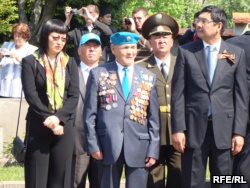
The delegation of Kazakhstan on the laying of wreaths at the monument to Soviet soldiers. First right: Kazakh Ambassador to the Czech Republic Anarbek Karashev. Prague, May 9, 2010.
Tokabaev did not like the falsification of history from the very beginning, when a completely different tank was put up on a pedestal, and it was announced in newspaper newspapers that it was the same tank, the real tank, Goncharenko. And further metamorphoses, debunking myths after the collapse of the communist system in Czechoslovakia, the relocation of the tank to the museum completely upset him.
Frankly, we didn’t get to the bottom of things. What they heard was what they believed. However, I think it was necessary to put the damaged tank itself. That would be a real monument. Since it was about the name of Goncharenko, it was necessary to put the same tank. So, the tank burned down, they say, and he died in this tank. It would be very helpful, it would be appropriate, ”says Kamatai Tokabaev.
But to admit, we did not begin to tell the veteran about the most striking events around the tank - repainting the tank in pink. We did not want to upset the work of a cardiologist who accompanied a strong man of 85 years old, who nevertheless dictated to us the numbers of units and formations, the addresses and phone numbers of his fellow soldiers.
Kamatai Tokabaev was discharged from the army in 1947. Then he was waiting for a standard work biography, also marked with medals and other awards. He worked on the railway for more than half a century, including at the station in his native village of Babatay, Arshali district, Akmola region. Doros to the head of the station. In 1984, retired. He brought up and brought four daughters into people. “I have six grandchildren and two great-grandchildren,” the veteran who ended the war in Prague proudly says.
65 years later, in the liberated Prague, a Kazakh veteran was awaited by the collapse of Soviet-era propaganda myths.
BLACK DYED THE TANK IN PINK
In Soviet times, the Soviet tank in Prague at number 23 was called the Smikhovsky tank. It just stood on the square in the Smikhov quarter, and this square from 1951 to 1990 was named after the Soviet Tankers Square. In the 1950s, the tank was given the status of a national cultural monument.
However, in 1989, the Iron Curtain fell in Europe and the time came for liberation from Soviet totalitarianism. In April 1991
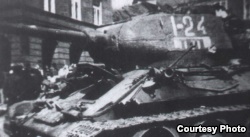
Tank of Lieutenant Ivan Goncharenko shortly after the battle in Prague on May 9, 1945. Photo from www.zanikleobce.cz
The citizens of Prague were shocked to see in the morning the Soviet tank in pink in the literal sense of the word. Such was the action of then student David Cherny and his friends. David Cherny later became popular as the author of children's figures, which he planted on the main television tower in Prague, a feeling that children crawl up and down the tower, like ants on a tree trunk.
David Cherny is called a controversial artist, an engaged artist also because he created a parody of the main monument to the founder of the Czech state - Prince Wenceslas. David Cherny turned the horse upside down and put Wenceslas on the horse’s belly.
To understand the motive of David Cherny’s work, one can perhaps draw parallels with public protests by Kazakh avant-garde artist Kanat Ibragimov. They are both politically engaged, both love to shock the audience with parodies of any social events. Only street performances of Kanat Ibragimov with chopping off a fish’s head or taking off his underpants reminiscent of the tricks of nervous Russian students from the time of 1905, and David Cherny raised his work to the level of criticism of totalitarianism.
So, after the fall of the communist regime in Czechoslovakia, they found that all these decades stood on a pedestal completely
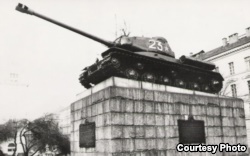
Monument to Soviet tankmen in Prague. Photo from www.zanikleobce.cz
A different tank than the one that first entered Prague. If Ivan Goncharenko fought on the tank of the famous T-34 model, then the tank stood on a pedestal of a completely different model, the IS-2, which also had nothing to do with the battles in Prague. In addition, the tank Goncharenko had the hull number 24, and on the pedestal stood the tank at number 23.
According to Czech historians, the substitution was the fault of the Soviet military leaders themselves, the commander of the tank army, General Dmitry Lelyushenko, allegedly said: "Nevertheless, we will not give the Czechs such junk." However, other Czech researchers say that the tank of Lieutenant Goncharenko was not damaged so much that it could not be repaired.
Against the background of conversations that there was no moral reason to leave the Soviet tank on a pedestal, David Cherny repainted the tank in pink one night in April 1991. So he expressed his personal protest against the invasion of Soviet tanks in Czechoslovakia in 1968, already in a completely different situation.
“I perceive this tank as a symbol of the Russian dictatorship, during which I was born. I don’t perceive this tank as a symbol of freedom, as a symbol of the end of World War II, ”David Cherny then explained to the local press his action.
A scandal arose. Discussions began in the press, and protest notes came from the Soviet government. David Cherny was imprisoned for several days. The authorities tried to hush up the noise by returning his green robe to the Soviet tank three days later.

Monument to Soviet tankers repainted in pink. 28 Prague, April 28, 1991. Photo from www.zanikleobce.cz
However, 10 days later, in the same spring of 1991, the tank turned pink for the second time. This time, 15 deputies of the Czechoslovak parliament came to the tank with buckets of pink paint and again walked through the armor with their own brushes. They exercised their right to immunity. President Vaclav Havel condemned the action of these deputies. And then passers-by dismantled the curb tiles around the tank and made an improvised monument from them to General Vlasov, whose armies ascribe the true liberation of Prague from May 5 to 8, 1945.
The collapse of myths and symbols of totalitarianism in Czechoslovakia occurred quickly; already in the summer of that same year, on June 13, they mounted a crane on a Soviet tank and pulled it off a pedestal with a commemorative plaque.
The tank stood in a museum for some time, and then migrated to the courtyard of the Military Technical Museum in a suburb of Prague. There he stands to this day. Since the dramatic repainting of the tank in 1991 was carried out hastily, these layers of paint fell away all the time. But the Czechs already called the tank the “Pink Tank”. And in 2000, in the museum, the tank was once again thoroughly painted pink. Now forever.
In June 2002, in Prague, on the site of a former monument to Soviet tankmen, a fountain called "The Hatch of Time" began to play.
“PINK TANK” IS RETURNING!
However, the legendary Soviet tank haunts some Czech activists, the same sculptor David Black and in the margins of history. The Pink Tank has hit the center of scandals in recent years at least three times. In his student youth, having successfully found his own theme, having successfully created his own style in art, David Cherny several times later benefited from the theme of the Pink Tank.
In 2001, the same sculptor David Cherny again shocked the audience with a work on the theme of the Pink Tank. He placed on the territory of the provincial town of Lazne Bohdanets a model of the rear of the tank, which seemed to be diving into the ground, and then without any authorization in May 2001 moved this artifact to a square in the center of Prague. The local administration opposed such a search, and the architectural composition was soon removed. Again, protests came from the very top. Czech Prime Minister Milos Zeman and Russian Ambassador to the Czech Republic Vasily Yakovlev expressed a negative reaction.
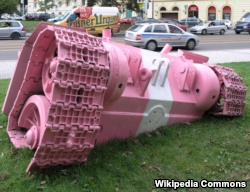
Artifact on the theme of the monument to the Soviet tank. Prague, August 21, 2008.
In August 2008, on the occasion of the 40th anniversary of the entry of Soviet troops into Czechoslovakia, David Cherny again returned the tank, or rather, its symbolic end face to the center of Prague. So he again reminded the public of the aggressiveness of the foreign policy of modern Russia. The local press wrote that even the model of the end of the “Pink Tank” itself weighs four tons, which required the use of a crane for the sponsor’s money.
It is worth noting here that these actions of David Black cause a different reaction in Czech society. Say, a representative of the Prague City Council (maslikhat, speaking Kazakh), a deputy from the Communist Party, Frantisek Hoffman, said that local organizations of veterans were asked to return the Soviet tank to its place. Frantisek Hoffman said that he did not accept the action of David Cherny with repainting the Soviet tank.
KRÁVA CÍSLO 23
Another story around the legendary tank of Lieutenant Ivan Goncharenko happened in the summer of 2004. In Prague, the Cow Parade - Cow Parade cultural event was held then. In the center of the city were exposed plastic figures of cows and bulls in full size and in natural colors. Such actions were held in other European capitals. 220 exhibits fell to Prague, many of which later went to auction.
The organizers beat in these figures and some stages of Czech history. For example, there was a cow, or rather, its figure under the name "Cosmonautics". One bull was given the name "Karel Gott", his figure was entwined with newspaper articles about this living legend of Czech pop music.
A cow under the name "Romeo" was set up in Kinsky Square, where once upon a time there was an ambitious Soviet tank. They wanted a cow for
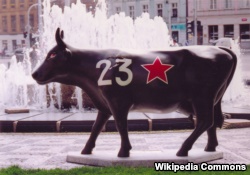
Figurine of a cow mimicking a monument to a Soviet tank. Prague, summer 2004.
The motif of David Cherny was painted pink, however, they settled on green. On the side they painted a red star and the number 23. Such was the number of the Soviet tank on the pedestal.
The representative of the organizers of the action, Martin Ratsman, explained to reporters that the intention to create this cow was not to discredit the memory of 144 thousand Soviet soldiers who fell in battle. Martin Ratsman convinced that the meaning of this cow figure was only a joke, an attempt to bring a smile to the citizens of Prague.
The ultimate goal of the Cow Parade campaign was to sell these figures at an auction for charity. However, good intention was overshadowed by the tricks of the vandals - many cows were simply smashed by cobblestones, beer bottles and so on. No luck and the cow-tank. Its sides in September 2004 received huge holes. The names of the three students who laughed with a cow-tank were identified. Scandal again, again political embarrassment.
But the situation was defused by two deputies of the Czech parliament - Jan Mladek and Jiří Dolejš, who bought the figure of a tank cow for 46 and a half thousand crowns. At that time, this amount exceeded two thousand dollars. “Thus, we want to prevent further mockery of the memory of the fallen heroes. We redeem this artifact as private individuals, ”said Jiří Dolejš.
It was announced that the cow-tank itself would be restored and housed in Southern Bohemia under the guise of the most ordinary local cow. These two deputies of the parliament and the company organizing the Cow Parade campaign did not raise any material claims against the three students who had pierced the sides of the plastic cow.


